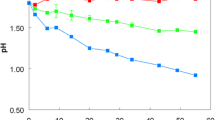Abstract
Vitamins B6 and B12, biotin, folates, riboflavin, nicotinate, pantothenate, biopterin, and vitamin C (l-ascorbate) were assayed in Poteriochromonas stipitata, Euglena gracilis, and Tetrahymena thermophila cells grown in defined media and in spent culture supernatants. P. stipitata and E. gracilis synthesized, stored and excreted folates (mainly as 5-methyltetrahydrofolate), B6, riboflavin, pantothenate, nicotinate, biopterin, and ascorbate. E. gracilis synthesized and stored biotin. T. thermophila did not synthesize the above vitamins except for B12, biopterin, and ascorbate; it excreted biopterin and stored B12 and ascorbate. Thiamin was left of consideration because all 3 organisms are thiamin auxotrophs. Possible ecological implications of these findings are considered.
Similar content being viewed by others
References
Aaronson S, DeAngelis B, Frank O, Baker H (1971) Secretion of vitamins and amino acids into the environment by Ochromonas danica. J Phycol 7:215–218
Baker H, Frank O (1968) Clinical vitaminology: methods and interpretation. John Wiley and Sons, New York
Baker H, Frank O, Thomson AD, Feingolds S (1969) Vitamin distribution in red blood cells, plasma and other body fluids. Am J Clin Nutr 22:1469–1475
Baker H, Frank O, Shapiro A, Hutner SH (1980) Assay of unconjugated pteridines in biologic fluids and tissues with Crithidia. In: McCormick DB, Wright LD (eds) Methods in enzymology. Academic Press, New York, pp 490–500
Bednar TW, Holm-Hansen O (1964) Biotin liberation by the lichen alga Coccomyxa sp. and by Chlorella pyrenoidosa. Plant Cell Physiol 5:297–303
Bhattacharjee JK (1970) Microorganisms as potential sources of food. Adv Appl Microbiol 13:139–161
Burkholder PR (1963) Some nutritional relationships among microbes of sea sediments and waters. In: Oppenheimer CH (ed) Symposium on marine microbiology. C. C. Thomas, Springfield, pp 133–150
Carlucci AF (1970) The ecology of the plankton of La Jolla, California in the period April through September, 1967. II. Vitamin B12, thiamin, and biotin. Bull Scripps Inst Oceanog 17:23–31
Carlucci AF, Bowes PM (1970) Production of vitamin B12, thiamine, and biotin by phytoplankton. J Phycol 6:351–357
Cavari B, Grossowicz N (1977) Seasonal distribution of vitamin B12 in Lake Kinneret. Appl. Environm Microbiol 34:120–124
Droop M (1962) Organic micronutrients. In: Lewin RA (ed) Biochemistry and physiology of algae. Academic Press, New York, pp 131–159
Hatfield DL, von Baalen C, Forrest HS (1961) Pteridines in blue green algae. Plant Physiology 36:240–243
Hutner SH, Provasoli L, Baker H (1966) Development of microbiological assays for biochemical, oceanographic and clinical use. Microchem J 1:95–113
Hutner SH, Corliss JO (1976) Search for clues to the evolutionary meaning of ciliate phylogeny. J Protozool 23:48–56
Hutner SH, Bacchi CJ, Baker H (1979) Nutrition of the kinetoplastida. In: Lumsden WHR, Evans DA (eds) Biology of the kinetoplastida. Academic Press, New York, vol 2, pp 653–691
Mateles RI, Tannenbaum SR (1968) Single-cell protein. Cambridge: MIT Press
McKinney RE (1973) Microbial relationships in biological wastewater treatment systems. In: Cairns J (ed) The structure and function of fresh-water microbial communities. Virginia Polytechnic Institute and State Union, Blacksburg, Virginia, pp 165–179
Nakamura K, Gowans S (1964) Nicotinic acid excreting mutants in Chlamydomonas. Nature 202:826–827
Nishyima T, Yoshihiko H (1979) Sensonal variation in the concentration of dissolved vitamin B12, thiamine and biotin in Susaki Harbor and Nomi Inlet. Repts USA Marine Biol Inst 1:1–8
Potty VH, Tamhane DV (1966) Distribution of folates in Ochromonas malhamensis. J Protozool 13:501–504
Provasoli L (1958) Nutrition and ecology of protozoa and algae. Ann Rev Microbiol 12:279–308
Provasoli L (1963) Organic regulation of phytoplankton fertility. In: Hill MH (ed) The sea, Vol 2. Interscience, New York, pp 165–219
Provasoli L, Carlucci AF (1974) Vitamins and growth regulators. In: Stewart WDP (ed) Algal physiology and biochemistry. University of California Press, Berkeley
Simpson FB, Neilands JB (1976) Siderochrones in cyanophyceae. J Phycol 12:44–48
Soldo AT, Godoy GA (1974) A requirement for an unconjugated pteridine for the growth of Paramecium aurelia. Biochim Biophys Acta 362:521–526
Author information
Authors and Affiliations
Rights and permissions
About this article
Cite this article
Baker, E.R., McLaughlin, J.J.A., Hutner, S.H. et al. Water-soluble vitamins in cells and spent culture supernatants of Poteriochromonas stipitata, Euglena gracilis, and Tetrahymena thermophila . Arch. Microbiol. 129, 310–313 (1981). https://doi.org/10.1007/BF00414703
Received:
Accepted:
Issue Date:
DOI: https://doi.org/10.1007/BF00414703




